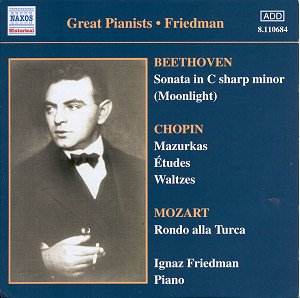One of the galaxy of Leschetizky
pupils, Friedman was a mature artist when
he came to record, in New York, at the end
of 1923. He hadn’t been invisible internationally
either. The Krakow born pianist made numerous
tours, routinely touring Egypt and Turkey,
as well as the cultural centres of North and
South America, Australasia and Japan. He lived
in Berlin until the start of World War One
and then left for Copenhagen where he was
based until the outbreak of the Second War
and flight to Australia. He died there in
1948, partial paralysis having truncated his
career a few years earlier.
His records preserve performances
of tremendous attack and staggering virtuosity
with characteristic features of huge dynamic
range, occasionally shattering attacks, teasing
accents, a flair for implicit or explicit
dance rhythms, and a dramatic, outsize Romantic
temperament. In many respects, as has often
been noted before, Friedman was the polar
opposite of fellow Leschetizky pupil Benno
Moiseiwitsch. The bulk of this fist volume
in Naxos’ projected Complete Friedman edition
is devoted to Chopin, of whose music he was
an acknowledged master, at least in certain
parts of the repertoire. Elements of egocentricity
do hover around his playing – try the spry
naughtiness of the Minute Waltz or the displacements
and daring stresses of the D Major Mazurka.
Against that is his fascinating vigour and
control – in the Etude Op 25 No 6 he exercises
stunning control at tremendous velocity managing
to inflect a variety of colouristic effects.
The Ballade in A Flat witnesses his huge dynamic
range and a kaleidoscopic approach to tonal
gradation whereas the D Major Mazurka is audacious,
clipped, insistent and lavished with Friedman’s
trademark rubato. If you think him too pugnacious
try the Revolutionary Etude – tempestuous
playing to be sure but perfectly scaled. No
quarter is given at the end of the Op 10 No
7 Etude whilst the A Minor Waltz is commensurately
lyrical and inward. Some surface chuffs intrude
on the Raindrop Prelude; his ornaments are
dramatically quick, dynamics huge, tempo not
excessive, rubato flexible but noticeably
active.
Elsewhere his exceptional
gifts are extravagantly on display. His own
arrangement of the Gaertner Dance is audacity
itself; agogics abound, Friedman letting loose
some thunderous bass notes and equally some
raptly still treble runs; his technique is
revealed as cast iron, his conveyance of mood
staggering, his profile ever teasing. There
is for instance daredevil panache in Hummel’s
Rondo, vigorous and masculine and yet with
a perfectly controlled set of dynamics. The
Mozart Rondo alla Turca and the Scarlatti
were experimentally recorded with strips of
wood over the piano to simulate a harpsichord
sonority. His accents are, as ever, unique
and his Scarlatti is full of wistful sobriety
and grace. The Mendelssohn Scherzo is dramatically
energised whilst the Liszt-Busoni La Campanella
is an increasingly spectacular display of
virtuoso pianism, including a staggering octave
ending marred only by its abrupt conclusion;
apparently there was not enough room for the
last few bars. It’s an interesting feature
of Friedman’s recorded legacy that he needed
a high number of takes for some of these items.
Whereas many colleagues would routinely be
covered by two or three takes, in the case
of Friedman he could take eight takes (the
Chopin Op 10 No 7 Etude) or even eleven takes
(Moskowski’s Serenata). There is a major sonata
here and that’s the Moonlight. He is melodic,
rubato rich, sensitive and affectionate in
the first movement, decisive and triumphant
in the second and plays with a magical sense
of control in the Presto Agitato concluding
movement. This is highly personalised and
romanticised playing but entirely effective
on its own terms. His own Elle Danse concludes
the recital; its characteristics might be
Friedman’s – capricious, naughty, rhythmically
decisive, deft, with vertiginous dynamics
and a winning profile. A splendid start to
what promises to be a major instalment in
Naxos’s Great Pianists series.
Jonathan Woolf


